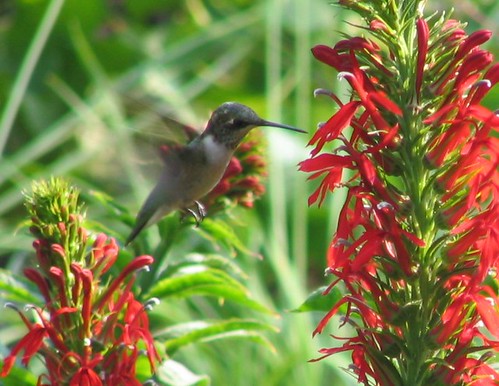 I used to love cardinal flower just because it's a gorgeous flower. It took a few years before I realized that if you sit quietly for long enough by a large patch, a hummingbird will come by. And that takes it to another level.
I used to love cardinal flower just because it's a gorgeous flower. It took a few years before I realized that if you sit quietly for long enough by a large patch, a hummingbird will come by. And that takes it to another level.Lobelia cardinalis has brilliant, deep red flowers. In his book Wildflowers: A Guide to Growing and Propagating Native Flowers of North America, William Cullina describes them like this:
 It is as if the flowers catch sunlight inside some sort of secret crystal matrix and let it bounce around for a while until it has been stripped of all but the deepest, purest red imaginable. Then and only then is the light released to burn crimson into our corneas.I will never forget the first time I found one in the wild, just a single plant growing in a low area behind my house. I stood there stunned for about five minutes trying to fathom how such a magical thing had come there.
It is as if the flowers catch sunlight inside some sort of secret crystal matrix and let it bounce around for a while until it has been stripped of all but the deepest, purest red imaginable. Then and only then is the light released to burn crimson into our corneas.I will never forget the first time I found one in the wild, just a single plant growing in a low area behind my house. I stood there stunned for about five minutes trying to fathom how such a magical thing had come there. Chances are, if he stood longer than five minutes, Cullina saw other magical things. The flowers don't have much of a smell. But that brilliant red is mightily attractive not just to humans, but to hummingbirds and butterflies -- especially, I've noticed, to eastern black swallowtail butterflies. If you find a patch, sit a while and see who comes by. Nothing is ever foolproof, but almost every time I have tried it, I have seen one or the other within twenty minutes. Just last week, a hummingbird started coming regularly last week to the patch of cardinal flowers in our yard, for the third year in a row.
Chances are, if he stood longer than five minutes, Cullina saw other magical things. The flowers don't have much of a smell. But that brilliant red is mightily attractive not just to humans, but to hummingbirds and butterflies -- especially, I've noticed, to eastern black swallowtail butterflies. If you find a patch, sit a while and see who comes by. Nothing is ever foolproof, but almost every time I have tried it, I have seen one or the other within twenty minutes. Just last week, a hummingbird started coming regularly last week to the patch of cardinal flowers in our yard, for the third year in a row.Cardinal flowers bloom in a long spike at the top of a stem that can grow up to 4 feet tall. The flowers are worth a close look: they're quite unusual. Plants in the genus Lobelia all have similar asymmetrical tubular flowers, with the tube slit along the upper side. The flower's five anthers are united around the style, forming a silvery-lavender point that itself almost glows against the red of the flowers.
 In the wild:Cardinal flower loves wet areas; you'll see it growing along streams or ponds. It's not the most common flower, but if you keep an eye out in these areas you should be able to find some.
In the wild:Cardinal flower loves wet areas; you'll see it growing along streams or ponds. It's not the most common flower, but if you keep an eye out in these areas you should be able to find some.In your yard: Cardinal flower is a perfect choice for a rain garden that catches water off your roof or any other wet spot in your yard. It can also be planted in normal, non-wet garden soil, especially with more shade -- it won't thrive during a drought, and it may not form as abundant a patch as it would with water, but it should do just fine. It's fairly easy to start from seed -- but be careful, the seeds are tiny!
Do you know a good cardinal flower patch? Any questions or observations? Leave a comment.
Like the photos in this post? Mouse over for credits; a click takes you to the photographer on Flickr.


